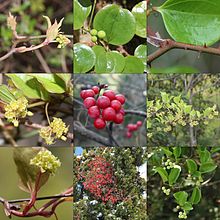Smilax china
| Smilax china | |
|---|---|

| |
| Fruits | |
| Scientific classification | |
| Kingdom: | Plantae |
| Clade: | Tracheophytes |
| Clade: | Angiosperms |
| Clade: | Monocots |
| Order: | Liliales |
| Family: | Smilacaceae |
| Genus: | Smilax |
| Species: | S. china
|
| Binomial name | |
| Smilax china | |
| Synonyms*[1] | |
| |
Smilax china is a climbing plant species in the genus Smilax. It is native to China, Korea, Taiwan, Japan (including Ryukyu and Bonin Islands), Philippines, Vietnam, Thailand, Myanmar, and India.[1][2][3][4][5][6][7][8] It also known as china root, china-root, or chinaroot,[9] as is the related Smilax glabra.
Description
[edit]The stem is woody, sparsely prickly, and 1–5 m (3 ft 3 in – 16 ft 5 in) long. Petiole is 0.5–1.5 cm (0.20–0.59 in) long; leaf blade is elliptic to orbicular, 3–10 cm (1.2–3.9 in) long and 1.5–6 cm (0.59–2.36 in) wide, sometimes wider. Berries are red, globose, and 0.6–1.5 cm (0.24–0.59 in) in diameter.[2]
Kaempferol 7-O-glucoside, a flavonol glucoside, can be found in S. china.[10]
Habitat
[edit]In China, S. china occurs in forests, thickets, hillsides, grassy slopes, and shaded places along valleys or streams. It is found from near sea level to 2,000 m (6,600 ft).[2]
References
[edit]- ^ a b Kew World Checklist of Selected Plant Families
- ^ a b c Chen Xinqi (陈心启 Chen Sing-chi); Tetsuo Koyama. "Smilax china Linnaeus, Sp. Pl. 2: 1029. 1753 菝葜 ba qia". Flora of China. Missouri Botanical Garden, St. Louis, MO & Harvard University Herbaria, Cambridge, MA. Retrieved 17 May 2015.
- ^ Merrill, E.D. (1922). An enumeration of Philippine flowering plants 1(2): 129-240. Bureau of Science, Manila.
- ^ Smitinand, T. & Larsen, K. (eds.) (1975). Flora of Thailand 2: 1-484. The Forest Herbarium, National Park, Wildlife and Plant Conservation Department, Bangkok.
- ^ Leroy, J.-F. (ed.) (1983). Flore du Cambodge du Laos et du Viêt-Nam 20: 1-175. Muséum National d'Histoire Naturelle, Paris.
- ^ Ohwi, J. (1984). Flora of Japan (in English): 1-1067. Smithsonian Institution, Washington, D.C.
- ^ Kress, W.J., DeFilipps, R.A., Farr, E. & Kyi, D.Y.Y. (2003). A Checklist of the Trees, Shrubs, Herbs and Climbers of Myanmar. Contributions from the United States National Herbarium 45: 1-590.
- ^ Baruah, S., Borthakur, S.K., Gogoi, P. & Ahmed, M. (2011). New distributional record of Smilax china Linnaeus (Smilacaceae) in India. Pleione 5: 328-330.
- ^ NRCS. "Smilax china". PLANTS Database. United States Department of Agriculture (USDA). Retrieved 16 November 2015.
- ^ Xu, W.; Liu, J.; Li, C.; Wu, H. Z.; Liu, Y. W. (2008). "Kaempferol-7-O-β-d-glucoside (KG) isolated from Smilax china L. rhizome induces G2/M phase arrest and apoptosis on HeLa cells in a p53-independent manner". Cancer Letters. 264 (2): 229–240. doi:10.1016/j.canlet.2008.01.044. PMID 18343026.
External links
[edit] Media related to Smilax china at Wikimedia Commons
Media related to Smilax china at Wikimedia Commons
